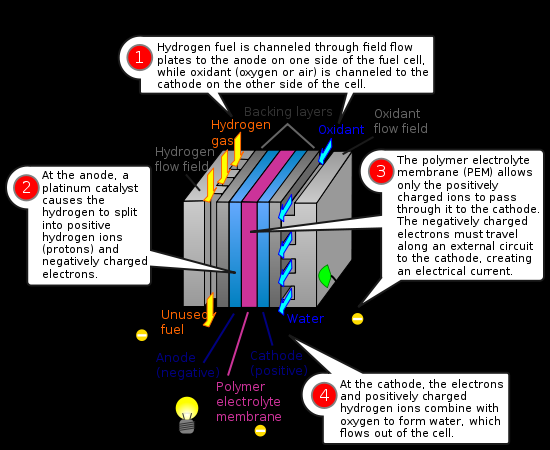
Тысячи-1 / Fuel cells - present
.docxA fuel cell is an electrochemical cell that produces electricity from a fuel tank. The electricity is generated through the reaction, triggered in the presence of an electrolyte, between the fuel (on the anode side) and an oxidant (on the cathode side). The reactants flow into the cell, and the reaction products flow out of it, while the electrolyte remains within it. Fuel cells can operate virtually continuously as long as the necessary flows are maintained.
Fuel cells are different from conventional electrochemical cell batteries in that they consume reactant from an external source, which must be replenished – a thermodynamically open system. By contrast, batteries store electrical energy chemically and hence represent a thermodynamically closed system.
Many combinations of fuels and oxidants are possible. A hydrogen fuel cell uses hydrogen as its fuel and oxygen (usually from air) as its oxidant. Other fuels include hydrocarbons and alcohols. Other oxidants include chlorine and chlorine dioxide.
A fuel cell works by catalysis, separating the component electrons and protons of the reactant fuel, and forcing the electrons to travel through a circuit, hence converting them to electrical power. The catalyst typically comprises a platinum group metal or alloy. Another catalytic process puts the electrons back in, combining them with the protons and oxidant to form waste products (typically simple compounds like water and carbon dioxide).
A typical fuel cell produces a voltage from 0.6 V to 0.7 V at full rated load. Voltage decreases as current increases, due to several factors:
-
Activation loss
-
Ohmic loss (voltage drop due to resistance of the cell components and interconnects)
-
Mass transport loss (depletion of reactants at catalyst sites under high loads, causing rapid loss of voltage)
To deliver the desired amount of energy, the fuel cells can be combined in series and parallel circuits, where series yields higher voltage, and parallel allows a higher current to be supplied. Such a design is called a fuel cell stack. Further, the cell surface area can be increased, to allow stronger current from each cell.

Direct-methanol fuel cell. The actual fuel cell stack is the layered cube shape in the center of the image
Proton exchange fuel cells
In the archetypal hydrogen–oxygen proton exchange membrane fuel cell (PEMFC) design, a proton-conducting polymer membrane, (the electrolyte), separates the anode and cathode sides. This was called a "solid polymer electrolyte fuel cell" (SPEFC) in the early 1970s, before the proton exchange mechanism was well-understood. (Notice that "polymer electrolyte membrane" and "proton exchange mechanism" result in the same acronym.)
On the anode side, hydrogen diffuses to the anode catalyst where it later dissociates into protons and electrons. These protons often react with oxidants causing them to become what is commonly referred to as multi-facilitated proton membranes (MFPM). The protons are conducted through the membrane to the cathode, but the electrons are forced to travel in an external circuit (supplying power) because the membrane is electrically insulating. On the cathode catalyst, oxygen molecules react with the electrons (which have traveled through the external circuit) and protons to form water — in this example, the only waste product, either liquid or vapor.
In addition to this pure hydrogen type, there are hydrocarbon fuels for fuel cells, including diesel, methanol (see: direct-methanol fuel cells and indirect methanol fuel cells) and chemical hydrides. The waste products with these types of fuel are carbon dioxide and water.
The materials used in fuel cells differ by type. In a typical membrane electrode assembly (MEA), the electrode–bipolar plates are usually made of metal, nickel or carbon nanotubes, and are coated with a catalyst (like platinum, nano iron powders or palladium) for higher efficiency. Carbon paper separates them from the electrolyte. The electrolyte could be ceramic or a membrane.

